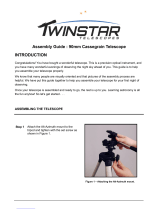
12
O
O
b
b
s
s
e
e
r
r
v
v
i
i
n
n
g
g
D
D
e
e
e
e
p
p
S
S
k
k
y
y
O
O
b
b
j
j
e
e
c
c
t
t
s
s
Deep-sky objects are simply those objects outside the boundaries of our solar system. They include star clusters,
planetary nebulae, diffuse nebulae, double stars and other galaxies outside our own Milky Way. Most deep-sky
objects have a large angular size. Therefore, low-to-moderate power is all you need to see them. Visually, they are
too faint to reveal any of the color seen in long exposure photographs. Instead, they appear black and white. And,
because of their low surface brightness, they should be observed from a dark-sky location. Light pollution around
large urban areas washes out most nebulae making them difficult, if not impossible, to observe. Light Pollution
Reduction filters help reduce the background sky brightness, thus increasing contrast.
S
S
e
e
e
e
i
i
n
n
g
g
C
C
o
o
n
n
d
d
i
i
t
t
i
i
o
o
n
n
s
s
Viewing conditions affect what you can see through your telescope during an observing session. Conditions include
transparency, sky illumination, and seeing. Understanding viewing conditions and the effect they have on observing
will help you get the most out of your telescope.
Transparency
Transparency is the clarity of the atmosphere which is affected by clouds, moisture, and other airborne particles.
Thick cumulus clouds are completely opaque while cirrus can be thin, allowing the light from the brightest stars
through. Hazy skies absorb more light than clear skies making fainter objects harder to see and reducing contrast on
brighter objects. Aerosols ejected into the upper atmosphere from volcanic eruptions also affect transparency. Ideal
conditions are when the night sky is inky black.
Sky Illumination
General sky brightening caused by the Moon, aurorae, natural airglow, and light pollution greatly affect
transparency. While not a problem for the brighter stars and planets, bright skies reduce the contrast of extended
nebulae making them difficult, if not impossible to see. To maximize your observing, limit deep sky viewing to
moonless nights far from the light polluted skies found around major urban areas. LPR filters enhance deep sky
viewing from light polluted areas by blocking unwanted light while transmitting light from certain deep sky objects.
You can, on the other hand, observe planets and stars from light polluted areas or when the Moon is out.
Seeing
Seeing conditions refers to the stability of the atmosphere and directly affects the amount of fine detail seen in
extended objects. The air in our atmosphere acts as a lens which bends and distorts incoming light rays. The
amount of bending depends on air density. Varying temperature layers have different densities and, therefore, bend
light differently. Light rays from the same object arrive slightly displaced creating an imperfect or smeared image.
These atmospheric disturbances vary from time-to-time and place-to-place. The size of the air parcels compared to
your aperture determines the "seeing" quality. Under good seeing conditions, fine detail is visible on the brighter
planets like Jupiter and Mars, and stars are pinpoint images. Under poor seeing conditions, images are blurred and
stars appear as blobs.
The conditions described here apply to both visual and photographic observations.
Figure 5-3
Seeing conditions directly affect image quality. These drawings represent a point
source (i.e., star) under bad seeing conditions (left) to excellent conditions (right).
Most often, seeing conditions produce images that lie somewhere between these two
extremes.

















